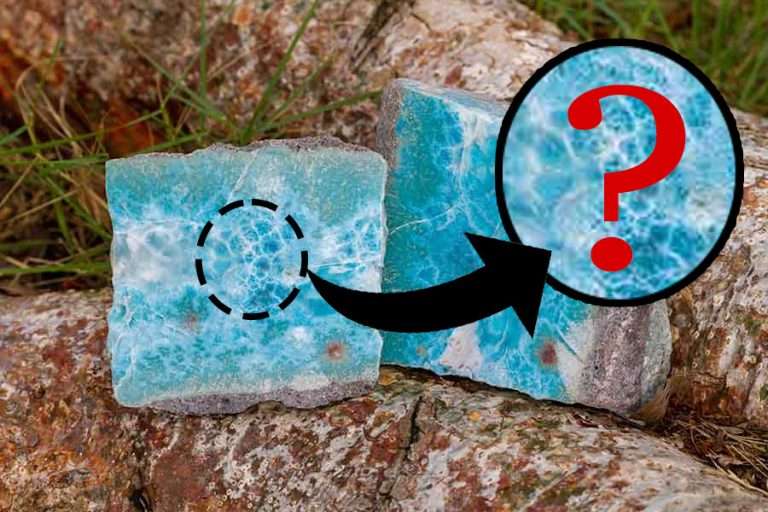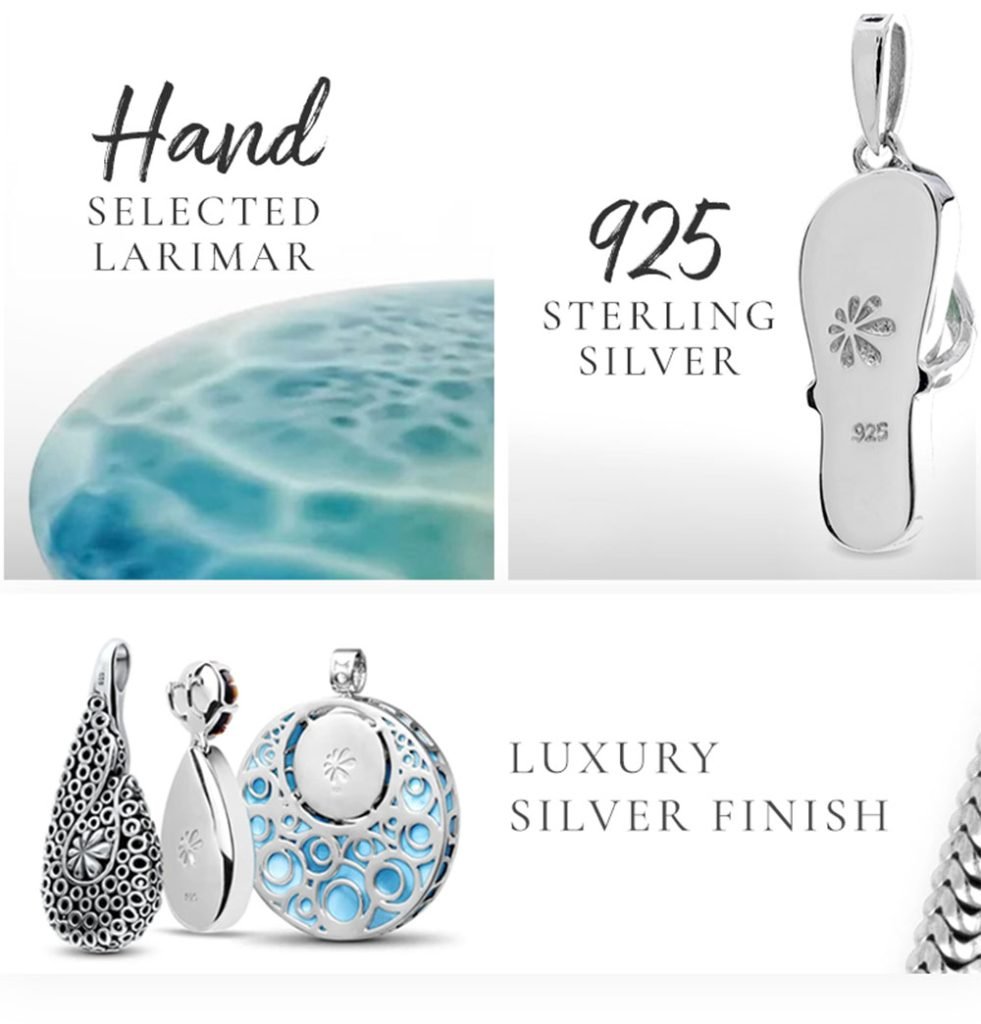If semi-precious stones have their own cache of best-kept secrets, then one of them is definitely Larimar, an extremely rare precious stone that has only been found in one very small location on the planet, a remote mountain range of the Dominican Republic in the Caribbean.
History of Larimar Stone
It is likely that the Taino Indians who inhabited the Island for a thousand years before Columbus arrived knew of Larimar, but it was not until 1916 that the first official records existed.
A Spanish missionary was in the area looking for gold and other precious resources that could be exploited and there are records of him requesting permission from the Dominican Government to explore the area.
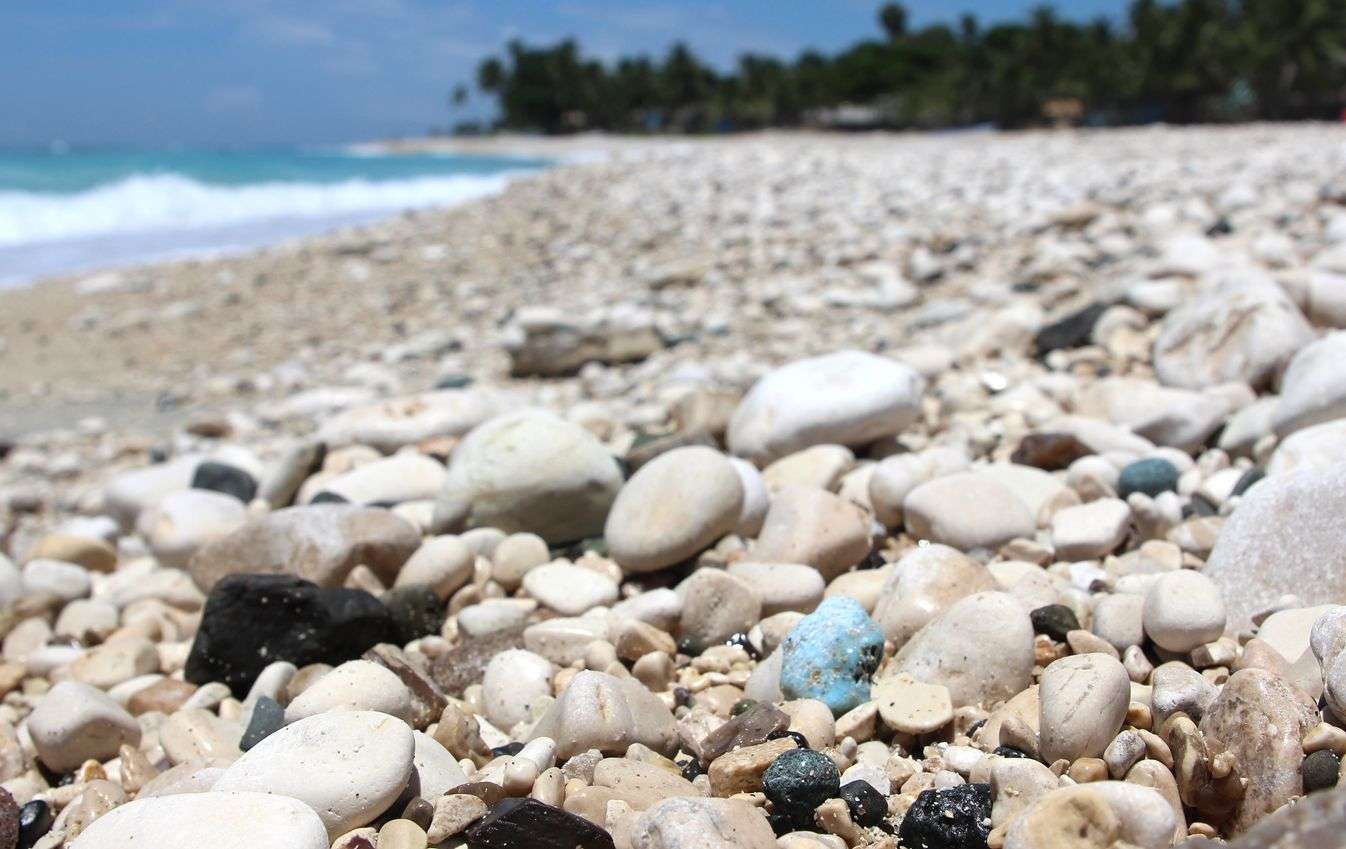
However, it is unclear what he knew and when he was sent back to Spain. There is no more mention of the stone until the 1950s.
How was Larimar discovered?
In 1957, the inhabitants of a small fishing village were finding fragments of a blue gemstone, we now know as larimar, washing up on the local beach.
It was believed that the larimar stones came from the sea and it took another 20 years for anyone to be interested enough to investigate this further.
As people became aware of the beauty of Larimar and started using it, the villagers set out to find the origins and followed the river upstream for a few days.
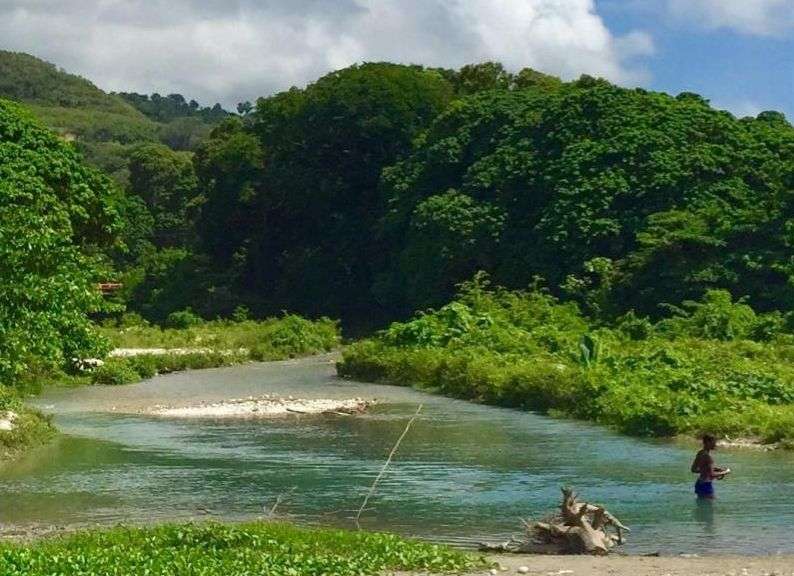
They tried several tributaries until they eventually found small outcroppings of the blue rock which we now know is the only known Larimar Deposit in the world.
In 1974, samples of larimar were sent by a Peace Corp volunteer to several geologists, including the Smithsonian Institute in Washington D.C.
It was only after their analysis that Larimar was found to be a previously unknown member of the Pectolite family.
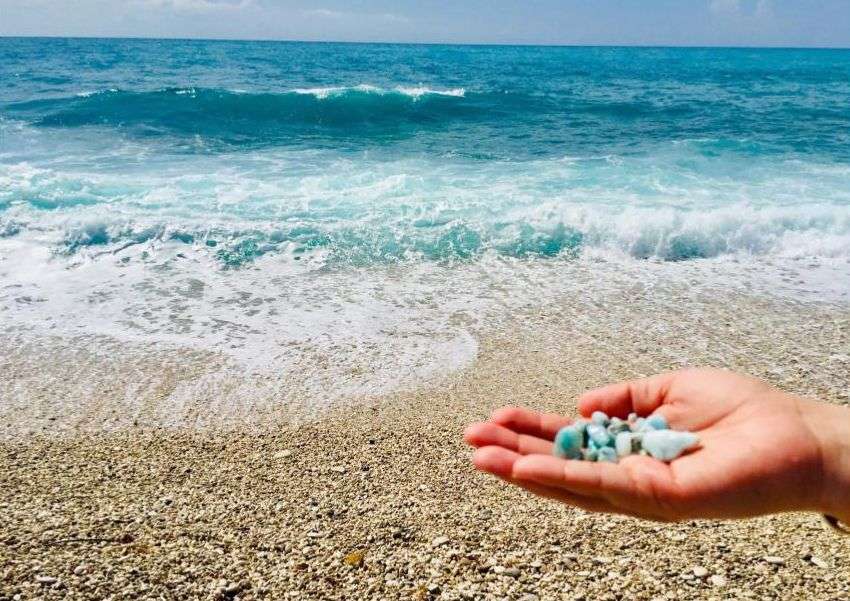
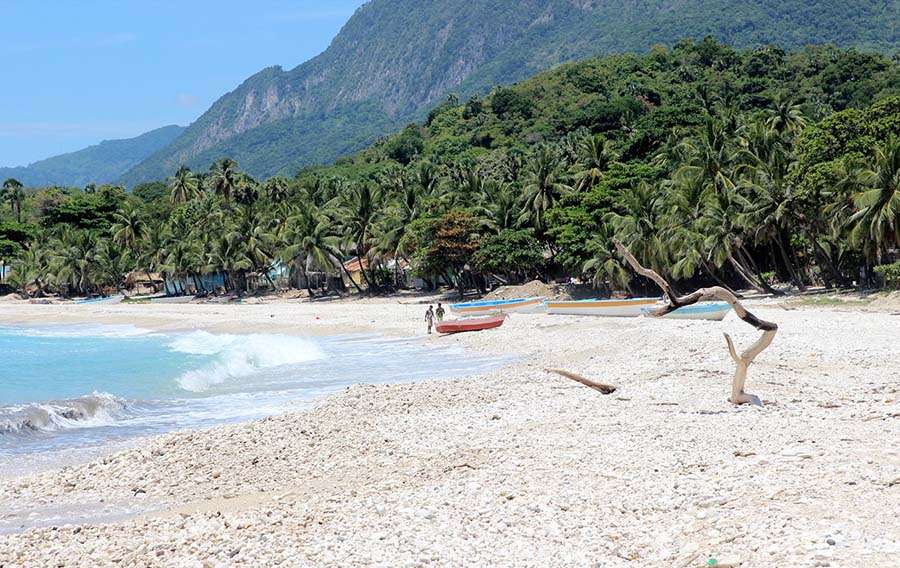
Where does the name Larimar come from?
Miguel Mendez was one of the early artisans using larimar and he named the beautiful material larimar after his daughter, “LARISSA”, and the Spanish word for sea, “MAR”.
There are other names which have been applied to Larimar, for example “the Atlantis stone” and “the dolphin stone”, both of which are intriguing and both represent different characteristics of this unique gemstone which we will go into later.
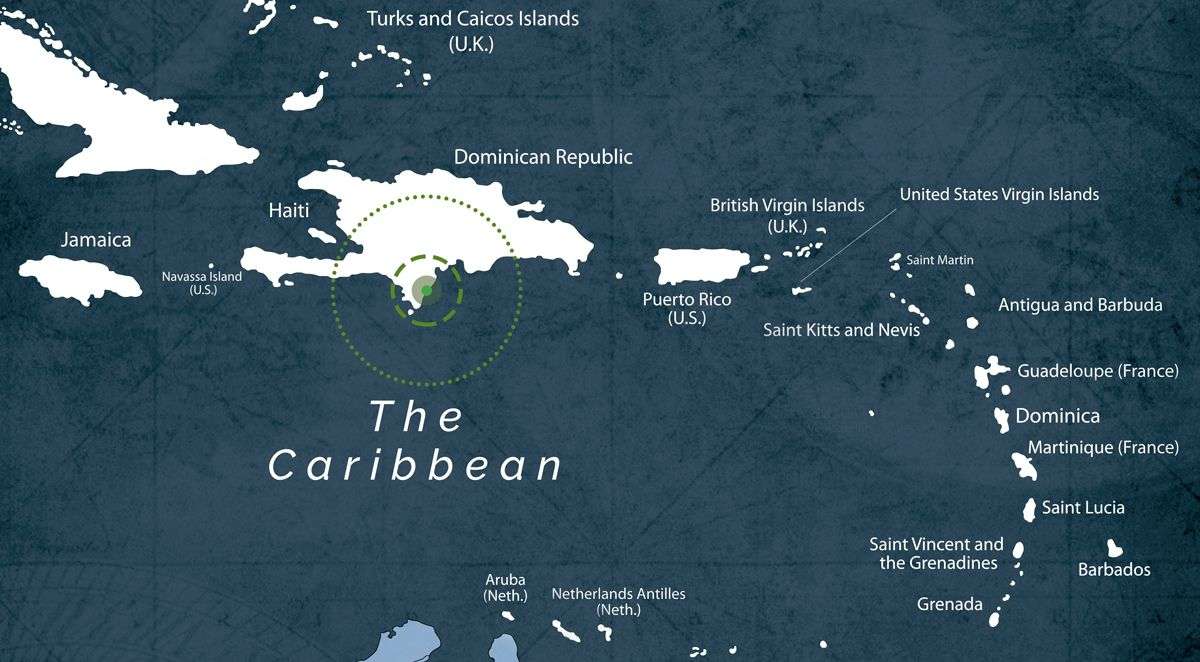
Larimar Geological Composition
Pectolite is the common name for Sodium Calcium Silicate Hydroxide (NaCA2Si3O8(OH)). Pectolite occurs in many places around the world as a whitish-gray transparent mineral.
Blue pectolite from the Domincan Republic and is unique because of its color and rarity and also because it is found in cavities of serpentinized ultramafic rocks (a special rock that does not fit into the three common categories of rock).
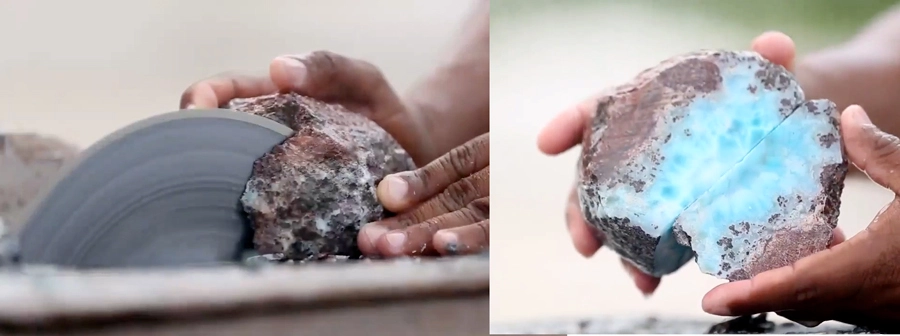
There are various elements which influence the properties of Larimar, such as Copper, Vanadium, Hematite, Phosphorus, and Silica. The exact process that formed larimar is unknown, but it is obviously due to the unique composition of these minerals in the area.
Electron microprobe analysis indicates that the different colored portions of larimar have a relatively uniform composition. This indicates that it is not the chemistry of Larimar that results in the color, but possibly other factors.
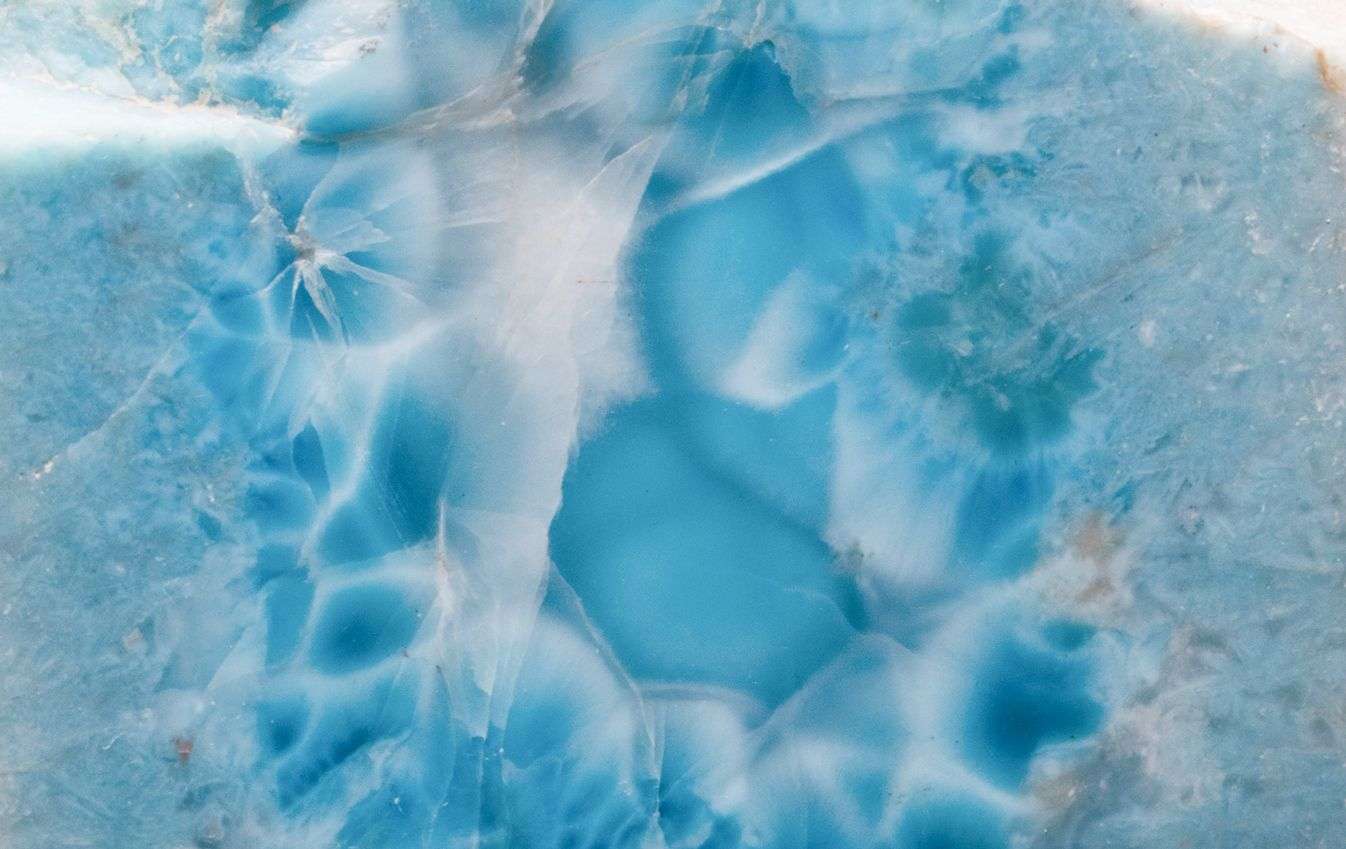
Copper is often thought to be responsible for the color, as it is in Azurite and Turquoise.
Interestingly though, the Copper concentrations have been found to be lower in the blue spherulites than in the paler white areas.
Copper occurs in Larimar in solid flecks which can occur microscopically or in much larger visible amounts.
There are some unusual samples of Larimar that have pure copper veins permeating the stone. Generally, it is thought that the concentration of copper is not high enough to be responsible for the color in Larimar.
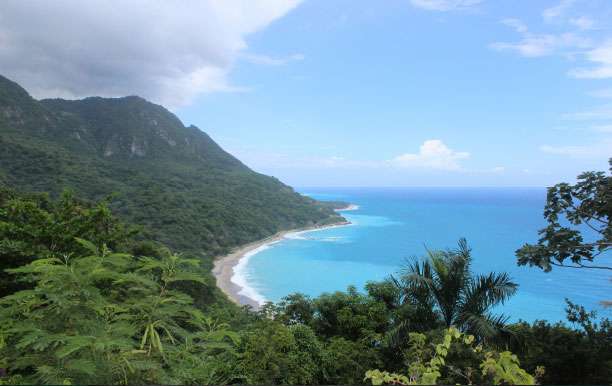
What color is Larimar
Larimar comes in a wide variety of colors ranging from gentle greens to the deepest blue. The patterns created during the cooling process give larimar its unique appearance, with so much variation that no two pieces are alike.
Why is Larimar blue?
The mechanisms that give gemstones their colors are generally poorly understood. When light strikes an object there are two separate processes that affect what we see, absorption and scattering.
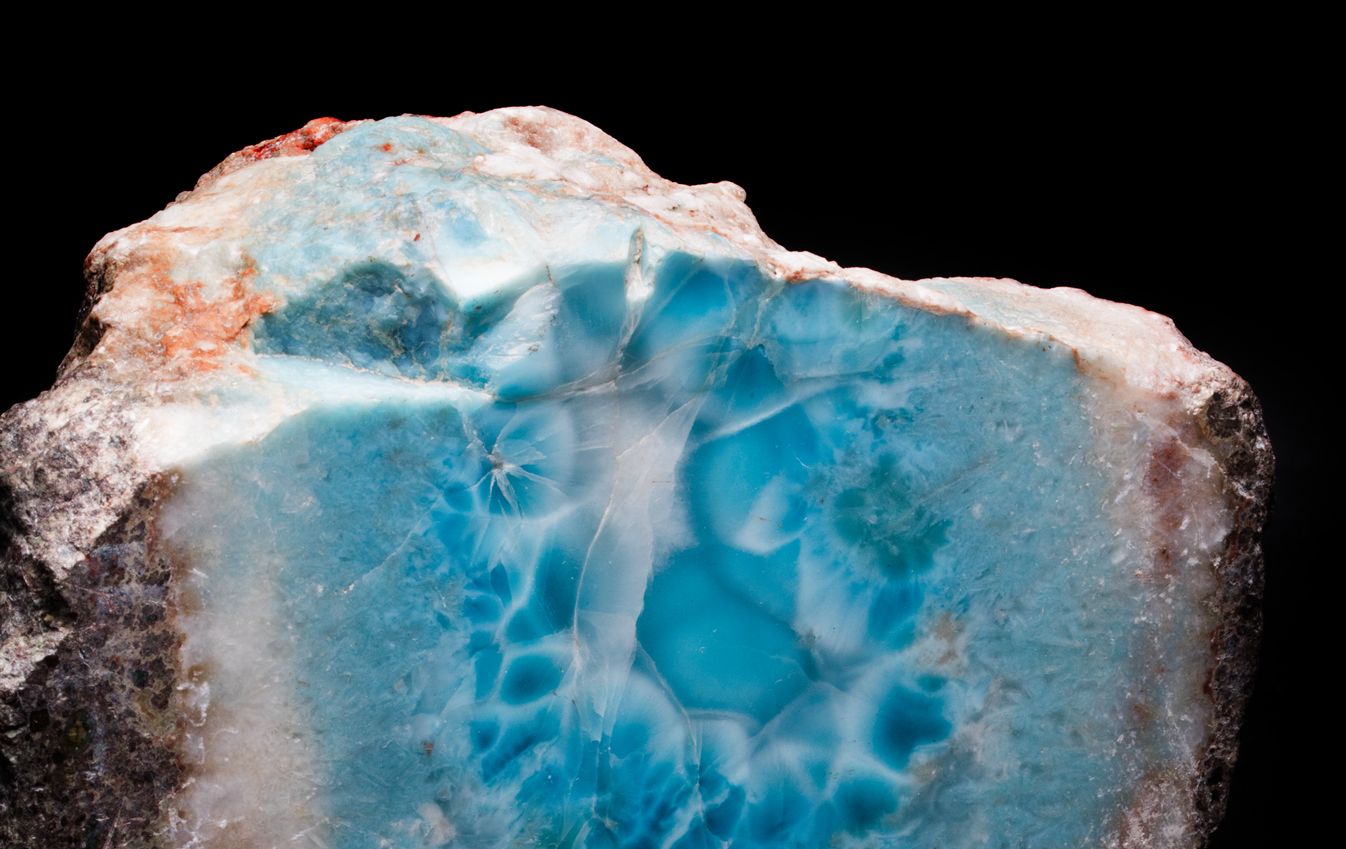
To better explain color mechanisms let us think of glacial ice. If the ice is thick, red wavelengths of light are absorbed, and the shorter blue wavelengths are transmitted (the ice appears blue).
If the ice is thin, all wavelengths are transmitted, thus it appears colorless, and these are examples of absorption. If the ice contains many air pockets (as snow does) the light can not penetrate and is reflected (appearing white), this scattering is known as the Rayleigh effect.
The sky is blue because particles in the atmosphere scatter the sun’s rays in the visible spectrum. The variation in color from zenith to horizon is due to varying concentrations of particles in the atmosphere.
It is possible that differences in the color of Larimar are the result of particles within the stone scattering different wavelengths of light.
Does Larimar come in different colors?
Larimar is found in various shades of white, blue and green, with blue being the most desirable. There is a lot of variation in the intensity of color and it is very common to have small areas of deep blue color surrounded by pale white or green area’s.
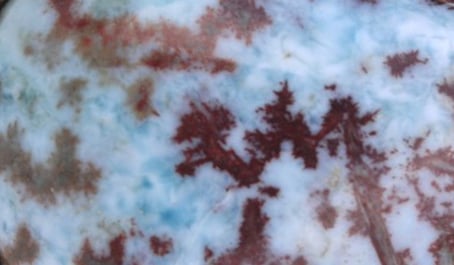
It is fairly common to see hematite dendrites around the edges of some rocks and they are sometimes reffered to as “red larimar”. While these pieces are very interesting and unusual, they are usually not used in the higher grades of jewelry quality stone.
You will also sometimes see “black larimar” this is not gem-quality material and is thought to be carbonized organic matter. It is soft and has no use so is usually thrown into the tailings along with the host rockand dirt.
Can Larimar change color?
While some gemstones such as Alexandrite show a distinct or dramatic shift in color under different light sources, color changes do not occur in Larimar.
Occasionally you will see an effect called Chatoyance, the cats eye effect, but it is usually only in the white crystalline area’s of the stone that are rarely used in jewelry.
Generally speaking, the smaller you cut Larimar, the lighter the stones become, so smaller gemstones, like ones in the Cheyenne bracelet, are not usually as intense as the pieces with larger pieces of Larimar, like the Brie Bracelet.
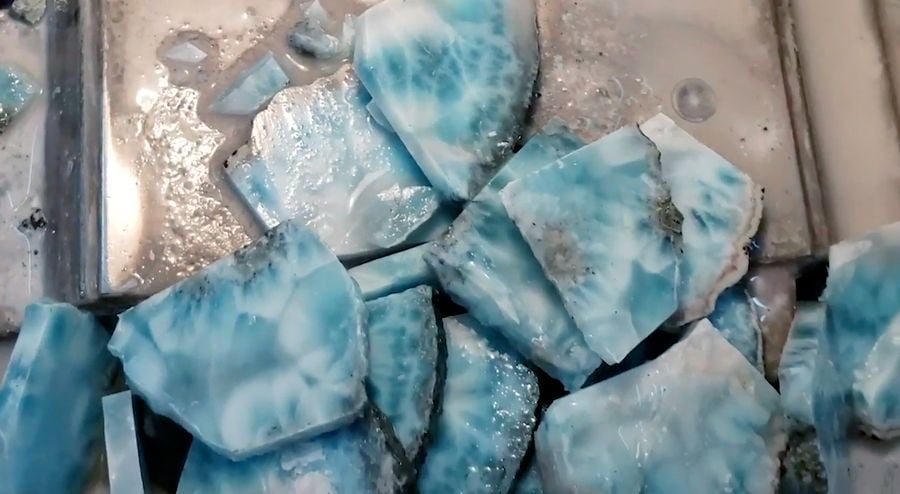
Does Larimar fade?
Larimar is a completely untreated gemstone and most dealers do not sell stones that have been treated, but on occasion, there have been known cases of larimar being soaked in a copper sulfate solution to make the stone temporarily appear darker.
The color in those pieces is short-lived and only lasts a few weeks. There are several articles online that mention larimar fading and while ultraviolet rays in sunlight will break down chemical bonds and cause the color of any object to fade, we have never encountered any problems.
Our assumption is that any object left in strong natural sunlight for any period of time will fade, but for normal day to day wear, this does not seem to be an issue.
Is Larimar Hard?
The hardness of larimar is from 4 to 7 on Mohs scale, depending on the crystalline structure of the stone.
Generally, the more intense blue and green specimens of larimar are the hardest, as they have the finest and densest needle structure. Larimar has been shown to be wearable every day, with simple gemstone bracelets, that have stood the test of everyday wear.
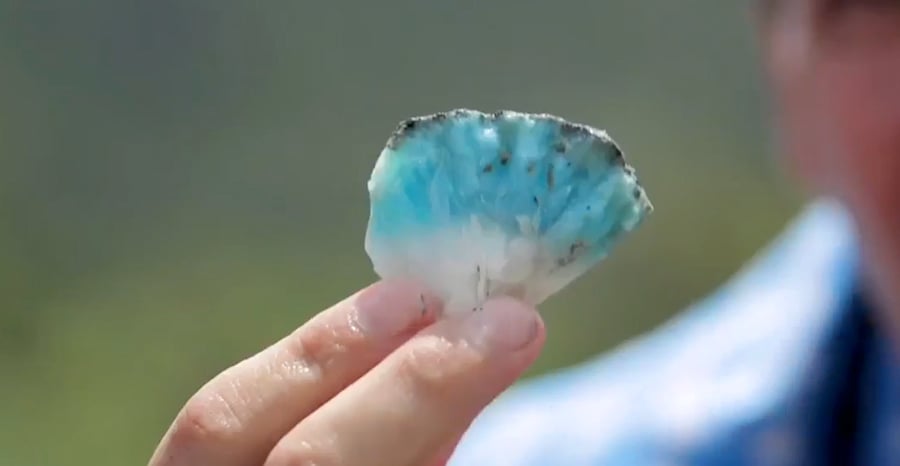
What gemstones come from the Caribbean?
Very few gemstones originate from the Caribbean islands, but larimar is by far the most popular. It is often referred to as the Gemstone of the Caribbean because the blues and whites mimic the sky and sea of the Caribbean where it is found. Other gemstones, besides larimar, that come from the Caribbean are Caymanite and Amber. There is also a rare type of blue Amber also found in the Dominican Republic.
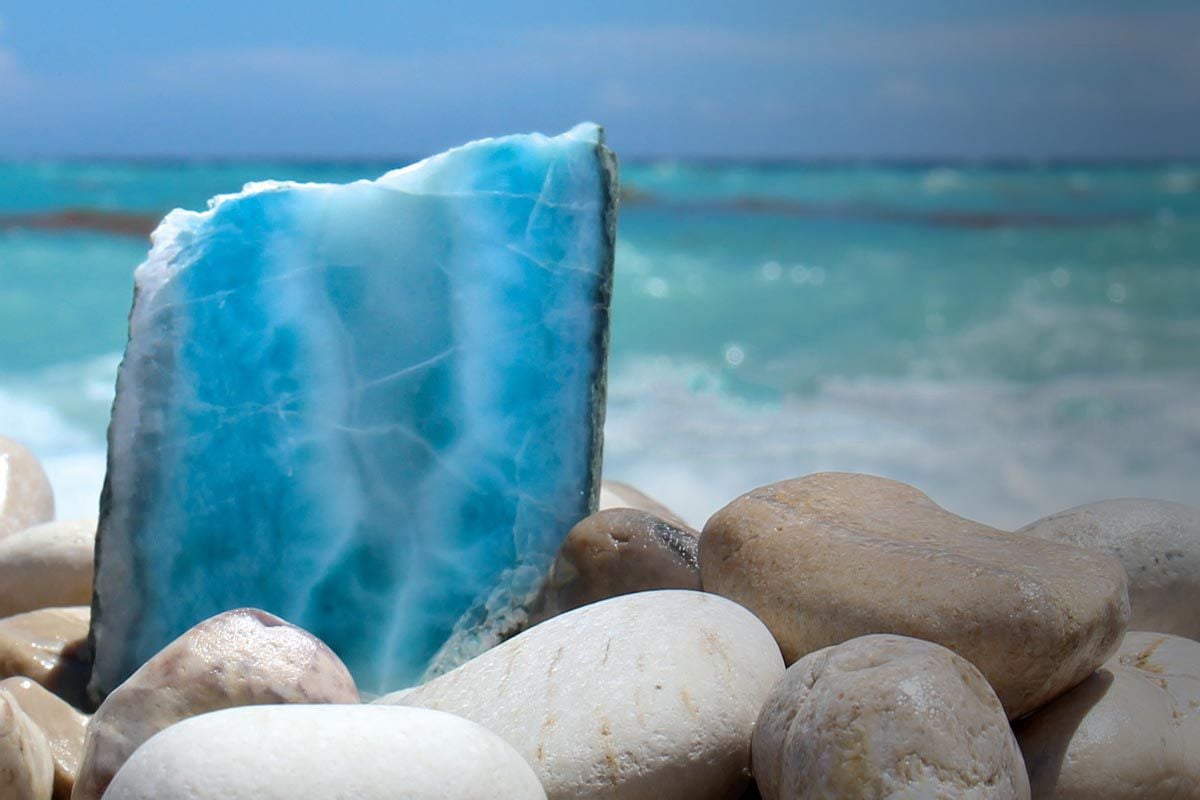
What is so special about Larimar?
While many people think we have found, studied and classified most animal, plants and minerals in the world, every now and then something new is discovered and larimar is one of these surprises. Larimar was first mined less than 50 years ago and is only found in one location on earth, a remote mountain region in the Dominican Republic. People are drawn, not only to the beautiful color, but also what it represents. Marahlago’s sealife pieces remain some of the more popular styles – evidence that this special gemstone ties in the earth, sky, and sea. The rare blue gemstone is also known to be a healing stone, which is just one of many metaphysical properties of Larimar.
Is Larimar rare?
Larimar Deposits have been found in only one place in the world: a remote mountain range on the Island of Hispaniola. The surface area of the gemstone deposits are thought to cover less than a single square mile. There are single source stones on every continent and one of the most well known is Tanzanite, which is mined in the foothills of mount Kilimanjaro and covers an area of approximately 8 square kilometers.
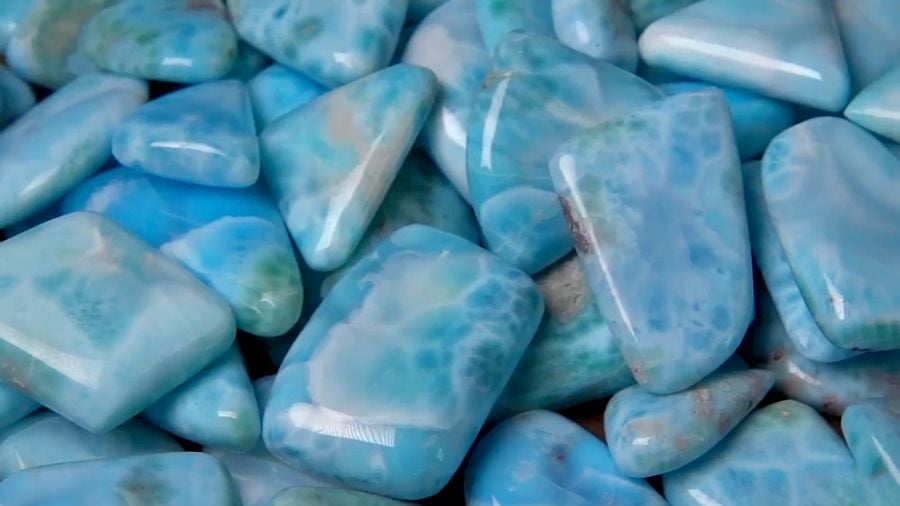
Will Larimar increase in value?
One of the most beautiful and rare gemstones on the planet, larimar has only ever been found in one, very small area in the mountains of the Dominican Republic. Over the last decade, this Caribbean gemstone has become one of the most sought after semi-precious gemstones in the world.
Forty years ago, this blue rare gemstone was found on the surface. Twenty years ago it was mined in shallow pits 20 to 30’ deep. Now the mine shafts have to go more than 600 feet underground! As the larimar mines continue to chase the deposit ever deeper, the difficulty and cost to extract the stone will naturally increase. So it seems safe to say, that unless a new deposit is found, larimar is most likely to increase in value.
Is Larimar expensive?
As larimar becomes more known and as companies like marahlago, continue to push the boundaries of what can be achieved, it is sure to increase in value. For instance, the Alexandria necklace takes 3-4 months and several kilo’s of larimar to make a single necklace. A piece of high-quality jewelry such as that has an incrementally different value than a simpler piece created with more rudimentary skills.
Every hundred feet farther into the ground, the miners have to dig makes this gemstone that much more difficult and costly to bring to the customer. There have been several price increases over the years, and it is realistic to think that the farther down the miners have to dig, the more expensive the stone will become.
Is Larimar the new Turquoise?
Turquoise is a semi-precious opaque, blue-to-green mineral with dark veins of various elements, that can be anything from quartz to metallic pyrite to sandstone. The Turquoise matrix is the term that describes the patterns of the Turquoise gemstone that is so popular and adored. In recent times, the Smithsonian suggested Larimar is becoming almost more valuable than diamonds.
The current main deposits of Turquoise are located in China, the United States, Mexico, and Tibet. The oldest deposit that was reported is at least 2000 years and comes from Iran. Today, many southwest American mines have run dry and are now closed.
Government restrictions as well as the high costs of mining have also impacted the ability to find jewelry-quality Turquoise ; because of it, most of today’s Turquoise is recovered as a byproduct of copper mining. This resulted in quality turquoise becoming increasingly harder to find.
Just as the Southwest American Turquoise mines were being depleted and no longer operating, a beautiful new gemstone was being discovered in the middle of the Caribbean with a bright blue color reminiscent of cloudy skies and Caribbean oceans, featuring mesmerizing lightning patterns running throughout the stone.
Unlike Gold, Diamond, Turquoise, Amber, and several other gemstones, which have been used in jewelry for thousands of years, Larimar doesn’t have a long history, with its earliest records dating back to 1916.
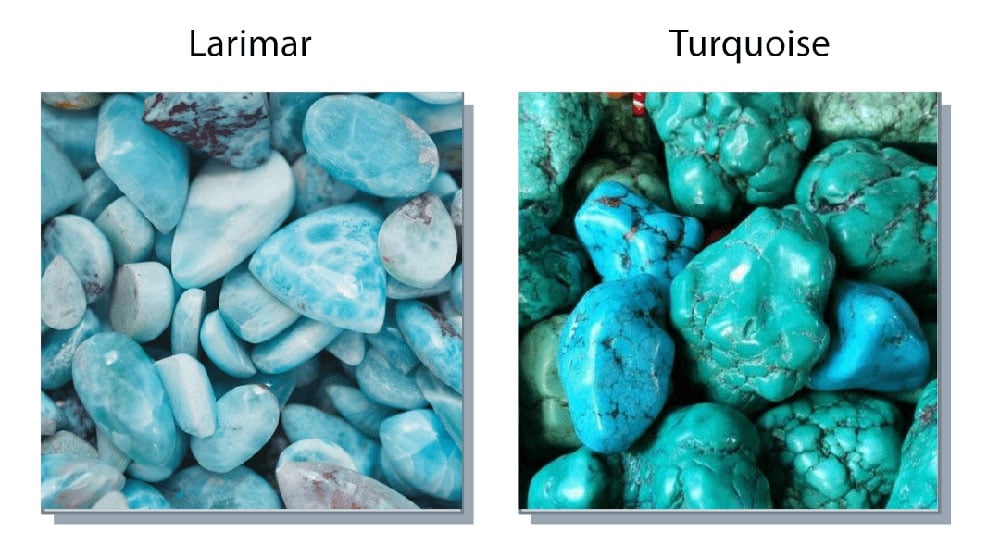
Because Larimar is a lovely blue color, some people confuse it with varieties of Turquoise. However, this blue pectolite is considered one of the rarest minerals on planet Earth and this is because its ONLY known source is in one remote mountain located in Bahoruco, Dominican Republic.
Looking at the color of the Larimar stone more closely, it displays a pastel ocean-like blue with some white specks, whereas Turquoise shows a more vivid and saturated green/blue tone.
Both Larimar and Turquoise have some pretty distinct patterns. Turquoise contains dark or brown veins and can have brown and grey spots throughout the stone, whereas Larimar has a smooth light blue surface decorated with a web of white lines/spots.


